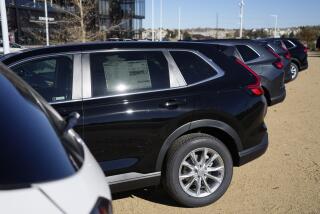Auto prices rise in U.S. despite sluggish sales
Reporting from Detroit — Though sales of cars and trucks in the U.S. continue to be more sluggish than expected, automakers are enjoying the largest increase in average transaction prices in more than five years.
Industrywide, consumers spent an estimated average of $29,217 on a new car or truck from January through May — an increase of $1,057, or 3.7%, from last year, according to estimates provided by Edmunds.com. Edmunds’ figures are based on a sampling of data from about 40% of U.S. dealers.
The Detroit Three are outpacing the industry’s gains — giving the automakers an opportunity to improve profit margins. Edmunds says average transaction prices increased 5.5% for Chrysler, 4.3% for Ford Motor Co. and 3.8% for General Motors Co.
Thomas King, senior director at J.D. Power & Associates, said the recent financial collapse, which helped the automakers restructure and close extra plants, helped them reduce production and cut incentives.
“In the past, you had manufacturers focusing a little more on improving volume and reducing prices to get that volume,” King said.
Now, King said, automakers have embraced a more disciplined approach that represents a fundamental change in the dynamic of the industry.
Though the underlying reasons for the transaction increases are somewhat different for each automaker, they generally include inventory reductions, reduced incentives, a demographic shift among buyers this year and consumers’ deciding to buy new technology and options.
According to WardsAuto.com, GM had a 56-day supply of inventory at the end of June, while Ford and Chrysler stood at 59, which is lower than the historic averages for domestic automakers. Generally, a 60-day supply of inventory is considered optimal.
That has helped the three companies lower incentives by an average of 4.5%, or $156, per vehicle this year.
Toyota Motor Corp.’s prices have increased 4.1% through May, according to Edmunds.com. That happened even as the automaker boosted incentive prices by 22.3% to attract buyers despite its recent recalls, according to Autodata.
Also, all automakers are seeing average transaction prices increase this year because of a change in the type of consumers who are buying cars, said Jack Nerad, market analyst for Kelley Blue Book.
Because of the economic collapse, Nerad said the only consumers who are buying cars are those who are the most economically secure and with the best credit. Those buyers also are likely to be comfortable buying more-expensive cars loaded with options.
Ford has been working for several years to capture those buyers by reducing the number of options it offers and doing a better job of marketing the most desirable options, said John Felice, general marketing manager of the Ford division.
For example, Ford reduced the number of combinations and options it offered on its Ford Mustang to less than 10,000 from nearly 350,000 between 2008 and 2010.
“We just had too much complexity,” Felice said.
On Thursday, Ford said its 2011 Ford Fiesta would include options such as $322 illuminated scuff plates and a $136 illuminated shift knob.
At GM, fewer brands and popular new products are lifting prices. The automaker has shed four of its eight brands in the last year, and products such as its Chevrolet Equinox, GMC Acadia and Buick Enclave mid-size crossovers have been big hits, giving the company the highest average transaction price of any full-line automaker.
“Hot products that are in tight supply are pretty much the story,” said GM spokesman Tom Wilkinson. “Economics 101.”
Snavely writes for the Detroit Free Press/McClatchy.






